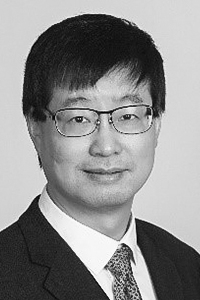Award Winners
Prof. Dr. Olivier Allix
École normale supérieure Paris-Saclay, France
Olivier Allix’ researches pertain to Simulation-Based Engineering Science. That discipline provides the scientific and mathematical basis for the simulation of engineered systems and aims at proposing and developing methods and concepts to solve industrial challenges.
His main activities concern the modelling of composites: damage crash …, multiscale approaches for non-linear structural mechanics (buckling, cracks propagation …), inverse approaches modelling and the objective prediction of failure in dynamics. Current researches concern non-intrusive computational techniques in order to enrich industrial simulations with physical based models. In cooperation with Professor Wriggers from Leibniz University, he plans to work on damage mechanics in conjunction with the virtual element methods, a new discretization scheme in engineering.



Prof. Dr. Hans-Albert Bachor
Australian National University, Australia
Professor Hans Bachor is a pioneer of research, teaching and communicating quantum optics and technology. After a PhD in Hannover, he established a laboratory and centre of excellence at the Australian National University. Communicating science is his passion.
With support from the Alexander von Humboldt Foundation, he has maintained many research links and is now mentor to a group of creative scientists in Germany, across Europe and in Australia. He has been rewarded with public honours in both Australia and Germany.



Prof. Dr. Steven Cundiff
University of Michigan, USA
Steven T. Cundiff is the Harrison M. Randall Collegiate Professor of Physics and Professor of Electrical Engineering and Computer Science at the University of Michigan. Prof. Cundiff is a Fellow of the APS, OSA, IEEE and AAAS.
Professor Cundiff works in the general area of ultrafast optics. His work spans the field from the generation of ultrashort pulses of light, their manipulation and using them to implement sophisticated spectroscopic techniques. A major activity in his group is the development and application of multidimensional coherent spectroscopy to a broad range of material systems from atomic vapours to semiconductor nanostructures. Other activities include novel methods of producing frequency combs, such as directly from inter-band diode lasers, using frequency combs to realize quantum interference control and to implement multidimensional spectroscopy. He also studies the dynamics of mode-locked lasers, which produce ultrashort pulses.
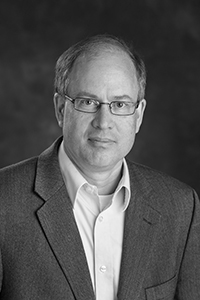


Prof. Dr. Hui Deng
University of Michigan, USA
Professor Deng’s research interest lies in the creation, control, and application of single-, few-, and many-body quantum states in matter-light coupled systems.
Her overarching goal is to develop useful quantum systems that bridge novel quantum phenomena with better technology. She has worked with a variety of semiconductor and photonic systems, including III-As exciton-polaritons, III-N quantum dots, van der Waals semiconductors, optical vortices, micro cavities and photonic crystals. Her current efforts include to understand and control strongly nonlinear polaritonic quantum fluids, understand coupled quantum systems and emergence of classicality from quantum, understand the optical and opto-electronic properties of van der Waals heterostructures, develop attojoule photonics device concepts based on van der Waals heterostructures, and control energy transfer and formation of many-body quantum states in materials by engineering the interactions with vacuum fields.



Prof. Dr. Andrew Forbes
University of the Witwatersrand, Johannesburg, South Africa
Andrew Forbes received his PhD (1998) from the University of Natal (South Africa), and subsequently spent several years as an applied laser physicist, first in a technology start-up where he was Technical Director, and later as Chief Researcher and Research Group Leader of the Mathematical Optics group at the CSIR. Andrew is presently a Distinguished Professor within the School of Physics at the U. Witwatersrand (South Africa) where he has established a new laboratory for Structured Light. Andrew is active in promoting photonics in Africa, a founding member of the Photonics Initiative of South Africa and initiator of South Africa’s Quantum Roadmap. He is a Fellow of both SPIE and the OSA, an elected member of the Academy of Science of South Africa and holds an A-rating by the South African NRF. He holds honorary professor positions in Stellenbosch, China and Japan and in 2015 won a national award for his contributions to photonics in South Africa. In 2020, he was awarded the Georg Forster award from the Alexander von Humboldt Foundation. Andrew spends his time having fun with the taxpayers’ money, exploring structured light in lasers as well as classical and quantum optics.



Prof. Dr. Naira Hovakimyan
University of Illinois, Urbana Champaign, USA
Naira Hovakimyan received her MS degree in Applied Mathematics from Yerevan State University in Armenia.She got her Ph.D. in Physics and Mathematics from the Institute of Applied Mathematics of Russian Academy of Sciences in Moscow. She is currently W. Grafton and Lillian B. Wilkins Professor of Mechanical Science and Engineering at UIUC.
She has co-authored two books, eleven patents and more than 450 refereed publications. She is the 2011 recipient of AIAA Mechanics and Control of Flight Award, the 2015 recipient of SWE Achievement Award, the 2017 recipient of IEEE CSS Award for Technical Excellence in Aerospace Controls, and the 2019 recipient of AIAA Pendray Aerospace Literature Award. In 2014, she was awarded the Humboldt prize for her lifetime achievements. She is Fellow of AIAA and IEEE. She is cofounder and chief scientist of Intelinair. Her work was featured in the New York Times, on Fox TV and CNBC.
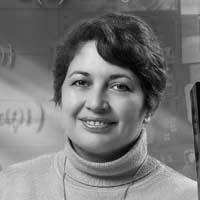


Prof. Dr. Thuc-Quyen Thai Nguyen
University of California, Santa Barbara, USA
Thuc-Quyen Nguyen is the Director of the Center for Polymers and Organic Solids (CPOS) and the professor in the Department of Chemistry & Biochemistry at the University of California, Santa Barbara (UCSB). Professor Nguyen received her B.S., M.S., and Ph.D. degrees in Physical Chemistry from the University of California, Los Angeles. She was a research associate in the Department of Chemistry and the Nanocenter at Columbia University. She joined the faculty of the Chemistry and Biochemistry Department at UCSB in July 2004.
Recognition for her research includes the 2005 Office of Naval Research Young Investigator Award, the 2006 National Science Foundation CAREER Award, the 2007 Harold Plous Award, the 2008 Camille Dreyfus Teacher Scholar Award, the 2009 Alfred Sloan Research Fellows, the 2010 National Science Foundation American Competitiveness and Innovation Fellows, the 2015 Alexander von Humboldt Senior Research Award, the 2016 Fellow of the Royal Society of Chemistry, the 2019 Hall of Fame - Advanced Materials, the 2019 Beaufort Visiting Scholar, St John's College, Cambridge University, the 2019 Fellow of the American Association for the Advancement of Science (AAAS), and the 2015-2019 World's Most Influential Scientific Minds; Top 1% Highly Cited Researchers in Materials Science by Thomson Reuters and Clarivate Analytics. Her current research interests are doping and charge transport in organic semiconductors, bioelectronics, and device physics of organic solar cells, ratchets, transistors, and photodetectors.
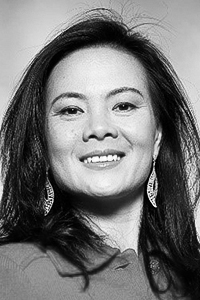


Prof. Dr. Markus B. Raschke
University of Colorado, Boulder, USA
Professor Raschke is internationally renowned for his highly original achievements in the field of near-field microscopy and nanooptics for ultrahigh spatial resolution imaging. By identifying fundamental optical processes, probing microscopic electronic and vibrational processes he has contributed to a deeper understanding of elementary processes in molecules and solids on the nanoscale.
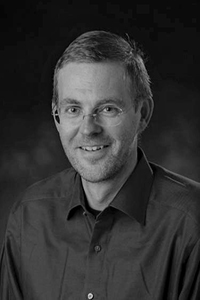


Prof. Dr. Batmanathan Dayanand Reddy
University of Cape Town, South Africa
Daya Reddy is a graduate of the Universities of Cape Town (UCT) and Cambridge, Professor Emeritus at UCT, and former holder of the South African Research Chair in Computational Mechanics. Starting in 1999, he served a seven-year term as dean of the faculty of science at UCT. His research is concerned with analysis and computation in continuum mechanics, motivated largely by applications in materials science and biomechanics.
Daya Reddy was a founder member in 2003 of AIMS, the African Institute for Mathematical Sciences (AIMS), a pan-African network with centres for graduate education, research and outreach in six African countries. He is actively involved in bodies that are engaged at the science-policy interface and recently completed a term as inaugural President of the International Science Council.
His various awards include the Order of Mapungubwe, presented by the President of South Africa for distinguished contributions to science, and of the Georg Forster Research Award from the Alexander von Humboldt Foundation in Germany.
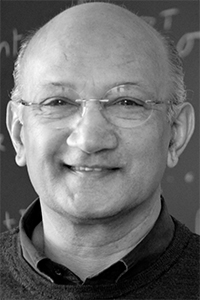


Prof. Dr. Andrey Rogach
City University of Hong Kong, China
Andrey L. Rogach is a Chair Professor of Photonics Materials at the Department of Materials Science and Engineering, and the Founding Director of the Centre for Functional Photonics (CFP) at City University of Hong Kong.
He received his Diploma in Chemistry (1991) and Ph.D. in Physical Chemistry (1995) from the Belarusian State University in Minsk, and worked at the Institute of Physical Chemistry of the University of Hamburg, Germany from 1995 to 2002. From 2002–2009 he held a tenured position of a lead staff scientist at the Department of Physics of the University of Munich, Germany, where he completed his habilitation in Experimental Physics. His research focuses on synthesis and optical spectroscopy of nanomaterials, and their use for energy-related and optoelectronic applications. His name is on the list of “100 Top Materials Scientists of the Past Decade” by Thomson Reuters (2011), and of Highly Cited Researchers (Clarivate Analytics 2018-2021). He holds honourable appointments as an Adjunct Professor at Trinity College Dublin (Ireland), an Honorary Professor at Xi’An Jiaotong University, Jilin University, and Peking University (China), and has been a Visiting Professor at Nanyang Technological University of Singapore. Andrey Rogach is a Foreign Member of the Academia Europaea (MAE) and a Fellow of the Electromagnetic Academy, USA. He is serving as an Associate Editor of ACS Nano since 2011, and received the Carl Friedrich von Siemens Research Award of the Alexander-von-Humboldt Foundation in 2018.



Prof. Dr. Samuel I. Stupp
Northwestern University, USA
Samuel Stupp is Board of Trustees Professor of Materials Science and Engineering, Chemistry, Medicine, and Biomedical Engineering at Northwestern University. He also directs Northwestern’s Simpson Querrey Institute for BioNanotechnology and the Center for Bio-Inspired Energy Science, an Energy Frontiers Research Center funded by the U.S. Department of Energy.
Stupp’s interdisciplinary research is focused on developing self-assembling supramolecular nanostructures and materials for functions relevant to renewable energy, regenerative medicine, and robotic soft matter. He is a member of the National Academy of Sciences, the National Academy of Engineering, the American Academy of Arts and Sciences, the Royal Spanish Academy, and the National Academy of Inventors. His awards include the Department of Energy Prize for Outstanding Achievement in Materials Chemistry, the Materials Research Society Medal Award, the International Award from The Society of Polymer Science in Japan, the Royal Society Award in Soft Matter and Biophysical Chemistry, and three national awards from the American Chemical Society: the ACS Award in Polymer Chemistry, the Ronald Breslow Award for Achievement in Biomimetic Chemistry, and the Ralph F. Hirschmann Award in Peptide Chemistry.



Prof. Dr. Jun Ye
University of Colorado, Boulder, USA
Jun Ye is a Fellow of JILA and a Fellow of NIST. He is a member of the National Academy of Sciences, a Fellow of the American Physical Society, and a Fellow of the Optical Society of America. His research focuses on the frontiers of light-matter interactions and includes precision measurement, quantum physics and ultra- cold matter, optical frequency metrology, and ultrafast science. He has co-authored over 300 scientific papers and has delivered over 500 invited talks. Awards and honours include N.F. Ramsey Prize (APS), Rabi Award (IEEE), US Presidential Rank (Distinguished) Award, three Gold Medals from the U.S. Commerce Department, Foreign Member of the Chinese Academy of Sciences, Frew Fellow of the Australian Academy of Science, I.I. Rabi Prize (APS), European Frequency and Time Forum Award, Carl Zeiss Research Award, William F. Meggers Award and Adolph Lomb Medal from the Optical Society of America, Arthur S. Flemming Award, Presidential Early Career Award, Friedrich Wilhem Bessel Award of the Alexander von Humboldt Foundation, and Samuel Wesley Stratton Award, and Jacob Rabinow Award from NIST. Group web page, http://jila.colorado.edu/YeLabs/
